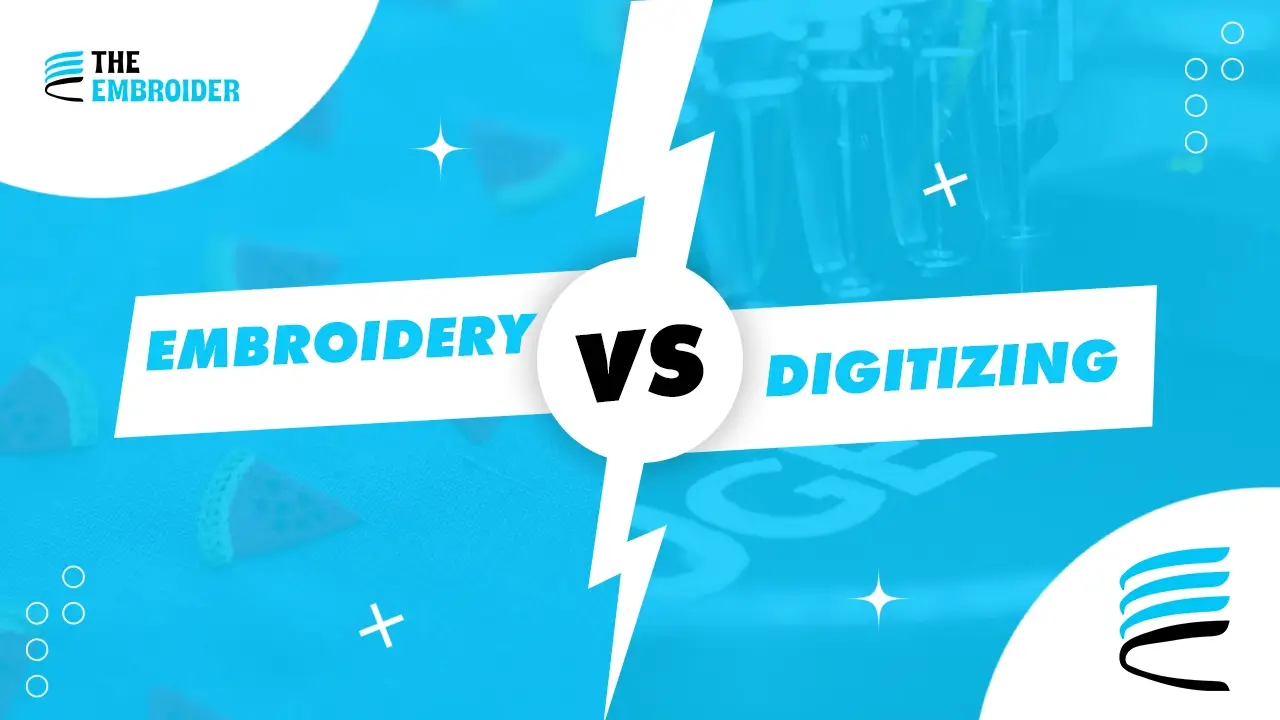Embroidery and Digitizing are relatively close to each other but also carry various differences altogether. Both have progressed notably over the time. Embroidery and Digitizing are the two fundamentals of the textile industry, which offers a bunch of creative ways to make more attractive fabrics with detailed designs. However, the techniques, procedures, and tools in embroidery and digitizing vary from each other. In this blog, we will distinguish between embroidery and digitizing by sorting out their main and specific features and characteristics and the impact they are absorbing from modern technologies over time.
Embroidery is the craft of stitching designs onto fabric by hand or with a machine, while digitizing is the process of converting a design or image into a digital file that can be read by embroidery machines for automated stitching.
i. The Art Of Embroidery
Embroidery is a vintage crafting industry that involves the furnishing of fabrics or other materials along with needles and thread. Embroidery has a rich historical background as it was practiced by various cultural civilians in the world. The principal characteristics of the term include :
- Handcrafted Expertise: Quilting is a hand-operated crafting that relies on the craftsman’s skills and agility. It requires hand-stitched crafts to create various complex designs and patterns, which range from simplicity to highly complex artistry.
- Skillfulness: Embroideries are widely applicable to various ranges of fabrics and other materialistic ornaments such as clothing, utensils, and many other types.
- Machine Embroidery: Machines can produce highly detailed designs and efficient crafting, which works faster than handmade embroideries, commonly used in the textile and fashion industry where logos are added, including monograms and other decorations to accessories and clothing, etc.
- Cross-Stitch: In cross-stitch, X-shaped stitches are used to form designs on fabric. It’s well known for creating detailed patterns and often used for decorative items.
ii. Digitizing
Digitizing, also known as technological advancements, replicates the process of converting digital artwork or designs in such a way that embroidery machinery understands and works on it. This process revolutionized the world of handcrafted embroidery and filled the gaps between physical embroidery and digital design.
Digitizing undergoes a variety of advantages for the embroidering industry across the globe.
- Level Of Accuracy: Digitizing offers a higher level of accuracy in making a replica of complex designs. On the other hand, it’s not that simple to get that pinpoint accuracy in manual embroidery.
- Speed Of Fulfillment: A design that is prepared through digitizing can be executed quickly compared to handmade crafts, which helps produce multiple bulk productions and fulfill the tasks before deadlines.
- Uniformity: Digitizing offers consistent designs across a whole number of items. Also, it maintains the topmost quality and the design throughout its lifespan. Nevertheless, manual embroidery lacks such uniformity and somehow makes a few mistakes over the period.
- Complex Designs: Digitizing helps the designer to design more effectively by making it more complicated along with more details. However, it’s impossible to achieve this via handmade embroidery.
Comparison Between Embroidery & Digitizing
Moving forward, we will analyze some comparisons between embroidery and digitizing via multiple points of view.
Expertise and Labor
- Digitizing is completely reliable on the machinery and the computer programs, which eventually reduces the basic need for extensive labor.
- Embroidery requires skillful artisans who are professionals in various areas of expertise.
Read More: Free Embroidery Digitizer Software
Design Complications
- Digitizing works for highly complex designs with accurate detailings and exact measurements.
- Hand embroidery can create efficient designs but could be limited by the skills of artisans.
Cost and Pricing
Embroidery digitizing service can save up the cost of excessive labor but requires initial investments in machinery and software development.
Manual embroidery is cost-effective due to the cost of labor and the consumption of time.
Conclusion
In conclusion, embroidery and digitizing have their own specific uniqueness in their era. They occupy their own set of strengths as well as technical advancements. Hand embroidery has its worth for its artisan quality. As still a lot of people believe and consider handicrafts more than digitizing as, according to them, it would bring more elegance and efficiency to the world of the textile industry.
On the other hand, Digitizing has been preferred by the modern group or culture whose demands are more likely of precisions and efficient designs along with perfections in the scalings.
Lastly, both embroidery and digitizing contribute to a rich weaving industry of textile designs, which ensures that creativity has no boundaries, especially in such a competing modern world.

